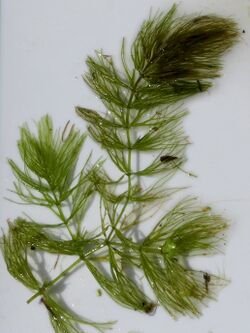Biology:Ceratophyllum echinatum
| Ceratophyllum echinatum | |
|---|---|

| |
| Scientific classification | |
| Kingdom: | Plantae |
| Clade: | Tracheophytes |
| Clade: | Angiosperms |
| Order: | Ceratophyllales |
| Family: | Ceratophyllaceae |
| Genus: | Ceratophyllum |
| Species: | C. echinatum
|
| Binomial name | |
| Ceratophyllum echinatum A.Gray
| |
Ceratophyllum echinatum, known as prickly hornwort, spiny hornwort, or spiny coontail, is an aquatic, perennial plant found in North America.[1][2][3][4] Its name comes from fruits, which have a warty surface and long spines.[5] Spiny hornwort can be found in ponds and lakes, principally in eastern North America. It is the only species of its genus endemic to North America.[6]
Ceratophyllum comes from the Greek keras, "a horn" and phyllon, "leaf", which is alluding to the stiff and narrow leaf divisions. The specific epithet echinatum comes from echinus which means sea urchin or hedgehog.[7]
Description
Ceratophyllum echinatum is an aquatic herb. It does not typically have any roots with stems that are freely branching and up to 4 m (13 ft) in length. The leaves are submerged and they are usually in whorls of 5 to 12. Its flowers do not have any petals but have sepals (3 to 15) that are sometimes mistaken for petals. The flower is tiny, may be male or female, and contains about 12 to 16 stamens.[8] It blooms from February to July. The fruits have dry seeds with spines and a rough surface.[9]
Threatened and endangered status
Several states list this species as special concern (Maine, Tennessee), threatened (New York), or endangered (Maryland, New Jersey).[3]
References
- ↑ "Comprehensive Report Species - Ceratophyllum echinatum". NatureServe. http://explorer.natureserve.org/servlet/NatureServe?searchName=Ceratophyllum+echinatum. Retrieved 25 July 2019.
- ↑ Reznicek, A. A.; Voss, E. G.; Walters, B. S., eds (February 2011). "Ceratophyllum echinatum". University of Michigan Herbarium. https://michiganflora.net/species.aspx?id=810.
- ↑ 3.0 3.1 "Threatened and Endangered Information". From the USDA. http://plants.usda.gov/java/profile?symbol=CEEC2.
- ↑ "Ceratophyllum echinatum". from Alabama Plant atlas. http://floraofalabama.org/Plant.aspx?id=1488.
- ↑ "Ceratophyllum echinatum - prickly hornwort - Ceratophyllaceae –". 7 February 2015. https://nyc.books.plantsofsuburbia.com/ceratophyllum-echinatumprickly-hornwortceratophyllaceae/. Retrieved 25 July 2019.
- ↑ "Ceratophyllum echinatum". From Flora of North America. http://www.efloras.org/florataxon.aspx?flora_id=1&taxon_id=233500338.
- ↑ "Origin of the Name". From the Robert W. Freckmann Herbarium. http://wisplants.uwsp.edu/scripts/detail.asp?SpCode=CERECH.
- ↑ "Species Information". Electronic Atlas of the Plants of British Columbia. http://linnet.geog.ubc.ca/Atlas/Atlas.aspx?sciname=Ceratophyllum%20echinatum.
- ↑ "Ceratophyllum echinatum A.Gray". From Robert W. Freckmann Herbarium. http://wisplants.uwsp.edu/scripts/detail.asp?SpCode=CERECH.
Wikidata ☰ Q5063798 entry
 |

